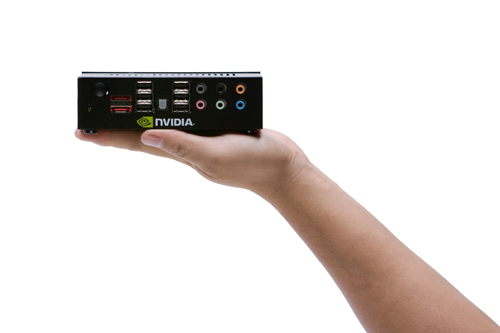Next wave of teeny PCs will remove another industry speed bump
April 2, 2009 by Dave Haynes

I really do wonder about what’s inside the heads of public relations guys who choose April 1 to issue a press release on a new product, particularly one that has been subject to tons of specualtion.
For example, Nvidia chose yesterday to issue a missive about its new Ion graphics processor, technology that will make the HD video playback of cheap and tiny CPUs like Intel Atom go from dubious to smooth and stable.
We assume the press release is no joke, and the propeller-head blog sites are saying the first units should be appearing on the market within a month, starting in China.
What this means is Acer, Asus and a small wave of other PC makers will be coming out with little boxes aimed at the home theatre PC market but pretty much perfect, also, for the digital signage market. Some are even being designed with VESA mount connectors — so they are already planned to slap on the back of big flat panels.
Aopen has dominated the digital signage market for about two years now with its little mini-PCs. They started just selling the consumer version, but as the orders started building they very cagily developed a more industrial-looking “Digital Engine.”
The problem, though, is that once it goes through the reseller channel the cost for a unit with an OS installed is anywhere from $600-$900, depending on who you talk to, and a bunch of other variables affecting price. Multiply that by a few hundred or a few thousand, in some cases, and it’s still too expensive.
It is is possible to build an Intel Atom-based unit right now for less than $400, but that’s using the Intel graphics capability and I have heard and read widely varied reports about its ability to be an effective DS player. I know some guys using the Asus EEE PC and they are happy as clams.
The Ion is touted to enable smooth, full HD playback of video and high-demand gaming, on a teeny box that may cost less than $200 if the OS is left out or Linux used. Windows, assuming the user stays above board and has a business version installed, might actually cost almost as much as the gizmo.
The consumer versions of these units are probably not what a network operator wants to roll out in big numbers. But for not much more there will be specialty gusy who will be able to do custom builds that are a little more ruggedized and tuned to the DS market.
This is all quite intriguing because while PC prices have dropped considerably over the last 2-3 years, that cost is still a big issue for many guys who are rolling out. If these little units are as good as promoted, this removes another speed bump on the road for this industry.
The Plan B for some guys operating on price has been to use a set-top box as a playout device. It’s generally cheap and reliable, but doesn’t do much and can’t really be developed to. This new wave will be real x86 PC platforms, meaning there are very few limitations.




Leave a comment